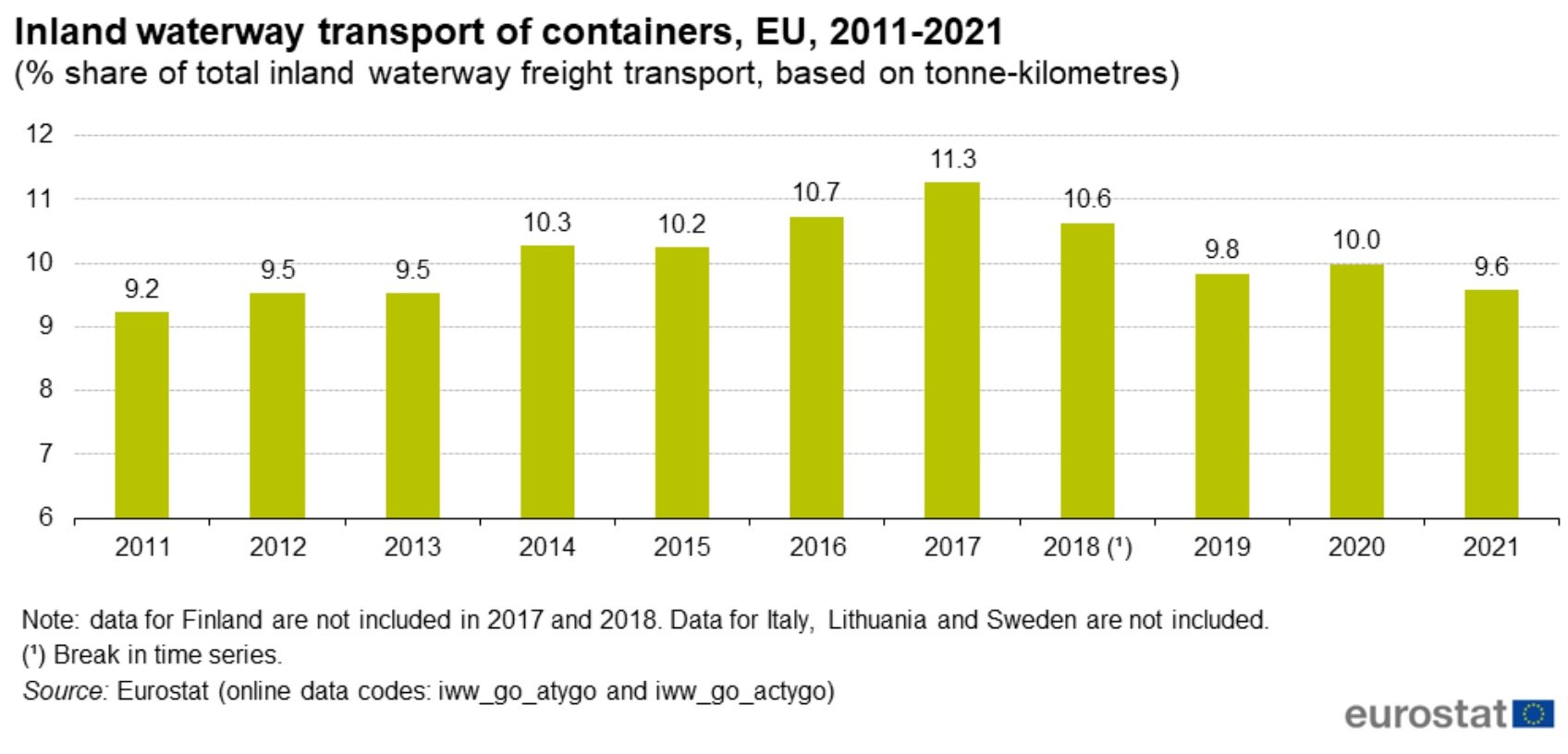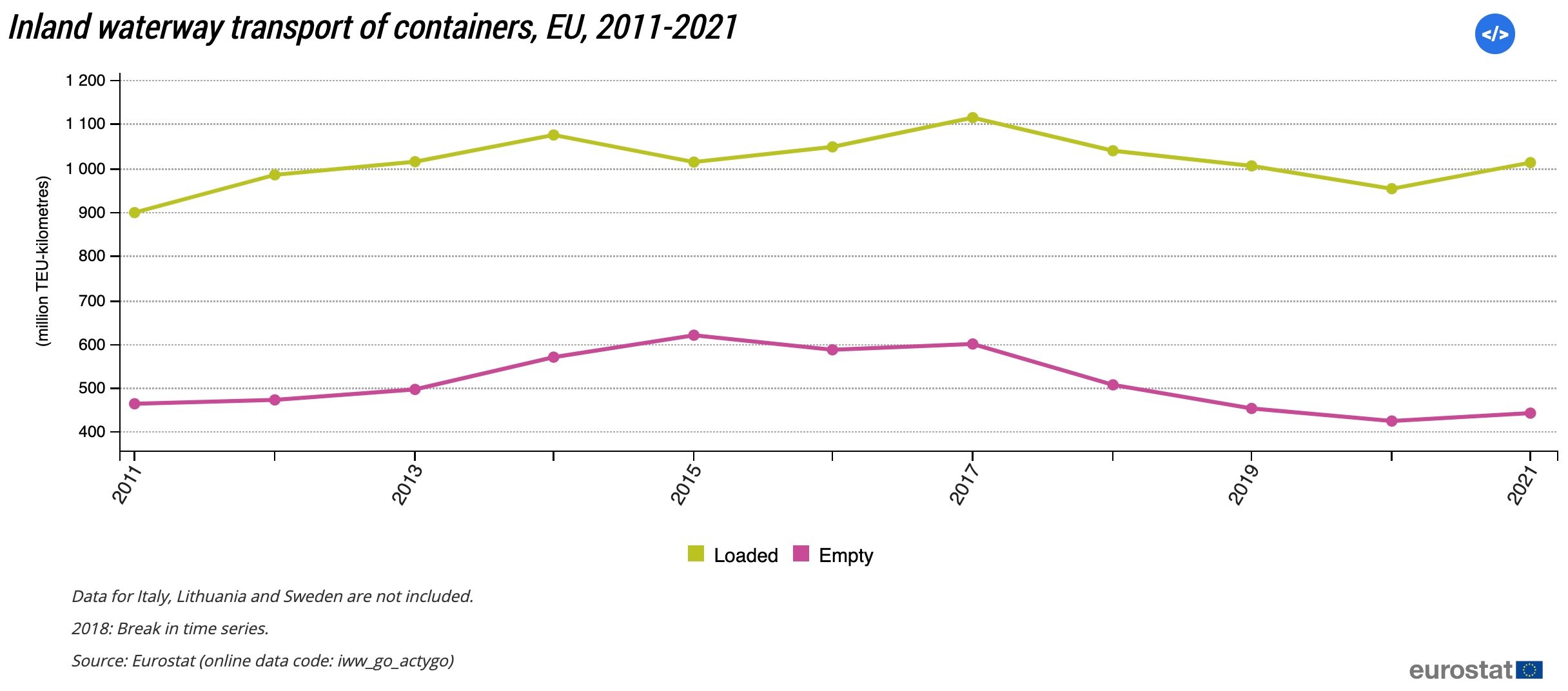
Europe is faced with increasingly intense and frequent periods of drought. The phenomenon could affect barge container transport strategy and transport prices.
The "low water surcharge" is a temporary, seasonal surcharge which shipping companies can apply to container transport operations involving inland waterways when navigability is affected by low water levels. It risks appearing increasingly frequently on bills from now on. Worse still, we have occasionally seen services halted because navigation has become impossible, as has happened, notably, on the Rhine.
Europe's current winter drought suggests that conditions will be difficult again in 2023. The paradox is that inland waterway transport, which is seen as a means of decarbonising freight transport and combating climate change, has itself become a victim of the consequences of climate change.
Last December, the Council of the European Union recognised "the strong impact of climate change on inland waterway transport, in particular on navigability, operations and water management, as evidenced by ground-water level changes but also by the severe droughts and periods of heavy rainfall in recent years." It also emphasised "the need to improve navigability by implementing the Good Navigation Status in line with the TEN-T guidelines".
The credibility of the European Commission's Naiades III programme depends on this happening. The programme provides for a series of measures to encourage modal switching and better integrate inland waterway transport into the vast trans-European intermodal system. But, for this to happen, inland waterway links need to be operational.
Container traffic stagnation
Navigability is not the only issue. It has to be admitted that, despite the ambitions for its development, inland waterway transport has tended to stagnate in recent years. This is particularly true in the container transport segment. In the EU, container transport's share of total inland waterway traffic in tonne-kilometres increased regularly from 2011 to 2017, when it reached a high point of 11.3%. Since then, however, its share has tended to diminish. There was a slight improvement in 2020 but this was immediately followed by a 0.4% reduction in 2021, taking container transport's share of total traffic down to 9.6%, according to Eurostat.

Traffic results in TEU-kilometres perfectly illustrate the segment's difficulties over the last three years. In 2021, full and empty container traffic totalled 1.45 billion TEU-km, up 5.6% on 2020, a year negatively impact by the Covid-19 pandemic. Compared to the traffic high point of 2017, however, this total represents a reduction of 15%.

The Netherlands, Belgium, Germany and France account for virtually all container traffic in the EU. Domestic traffic is predominant in France and the Netherlands, accounting for 78.2% and 46.8% of total container traffic in 2021. Conversely, in Germany and Belgium, international traffic is dominant, accounting respectively for 81.6% and 66.6% of total traffic. "Transit transport was significant only in the Netherlands and Germany, with shares at 13.2 % and 7.7 %, respectively, whereas it was less than 1 % in Belgium and France. This reflects the significance of these countries as hosts for major transit ports or as a major source or destination for container movements (Rotterdam, Antwerp and Hamburg)," Eurostats says in its analysis of the 2021 traffic results.
Structuring role in Germany and the Benelux
All these countries are today faced with the impact of climate change on the navigability of their waterways. The melting of the glaciers and the lack of rainfall in the Alps are starting to have a major impact on the Rhine and the Rhone, which are important rivers for goods transport purposes, as well as on the Po.
The water which feeds into these three rivers comes from the Saint Gothard Massif in Switzerland, where the Witenwasserenstock, Europe's well-named water tower, reaches a height of 3,083 metres. This summit, which acts as a triple watershed for the three river basins, is today in great difficulty. The big lakes on its flanks can no longer fully play their seasonal buffer role because they are too short of water.
The situation is particularly critical for the German economy, given that the Rhine has traditionally served as a structuring industrial artery. It provides an essential import-export link with the ports of Antwerp and Rotterdam.
- Disruption to navigation limits modal switching, making it difficult to carry out and, when the switch is made to the road, bringing into contradiction with decarbonisation targets
- It also affects prices. The shipping companies apply "low water surcharges". When it is caused by disruption, moreover, the change of transport mode also results in increases in road transport freight rates, as we saw on the German market in the third quarter of 2022.
- It also affects the role of the ports of Rotterdam and Antwerp, which are the leading "German" ports, ahead of Hamburg and Bremen. The problem is not, therefore, confined to Germany but has a real European dimension.
A source of concern in France
The abandonment of the Rhine-Rhone canal project by French environment minister Dominique Voynet in 1997, after many studies had already been carried out and 600 hectares of land had been expropriated, may turn out to have been a visionary decision. Had it been built, the canal would also have been affected by drought. After having been blocked initially for political reasons, the old dream of linking the North Sea to the Mediterranean by waterway has, in effect, been blocked a second time by climate change.
Low water levels on the Rhine have a direct impact on the port of Strasbourg-Ottmarsheim, France's biggest inland waterway port after Paris, and, by the same token, on the great eastern French hinterland. The Rhone has also suffered a fall in water flow, as well as an increase in water temperature. From the transport point of view, the impact has been less marked, given the relatively low volume of cargo transported between Lyons and Fos sur Mer. The main worry, as regards the Rhone, concerns the need to keep nuclear power stations operational at a time when demand for their services is high.
The Seine, which has been kept under tight control since the great floods of 1910, falls outside the triple watershed problem referred to above and so far, has been less exposed to the navigability problems caused by low water levels.
Possible modal switches
In the face of climate change and its consequences, the countries most concerned have no choice but to look for alternatives.
- Increasing rail capacity
In responding to difficulties on the Rhine, the railways are generally the preferred option. They do not offer a miracle solution, however, since rail infrastructure is susceptible to congestion problems. This means that the roads need to be used as an alternative, particularly to ensure that the Duisburg/Dusseldorf transport hub continues to function. The operational and environmental consequences are not very satisfactory but the German economy has no real alternative in the short term.
- The Seine-Nord canal project
Could Antwerp and Rotterdam play a role in speeding up the Seine-Nord Europe canal project ? If transporting containers by barge on the Rhine becomes really problematic, the two Benelux ports are going to have to find new sources of growth. Investing in a link to the Paris region could then become a necessity…which would be bad news for the Haropa port complex linking the ports of Paris, Rouen and Le Havre.
Because of the war in Ukraine, Europe has had to take emergency action to secure its supplies of oil and gas. We need to realise, however, that the water problem is even more crucial, given its particularly vital nature. There have been a number of alerts in recent years and it is time for European countries to start taking the problem much more seriously. Even if ambitious measures are taken to fight climate change, their effect will not be immediate. In the meantime, we are going to have to learn to live with the consequences of climate change, by trying to keep them down to a minimum but also by managing and anticipating conflicting demands for resources. The transport sector will need to find a way to ensure its voice is heard.

Jérôme de Ricqlès
Shipping expert
Our latest articles
-
Subscriber 2 min 19/12/2025Lire l'article -
Container shipping in 2025
Lire l'article -
Air cargo: the rerouting of flows is confirmed
Lire l'article


